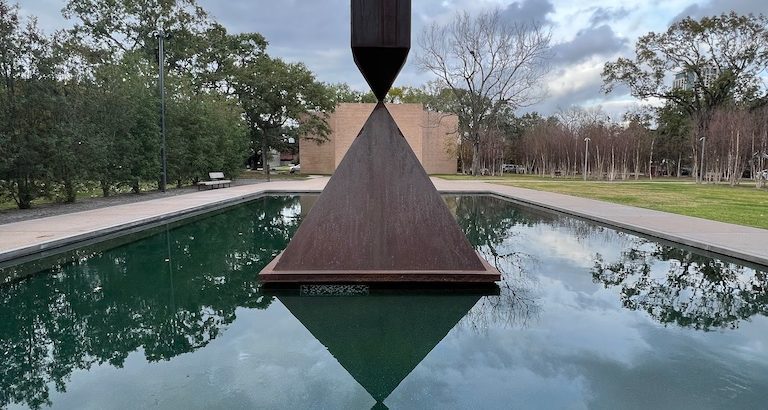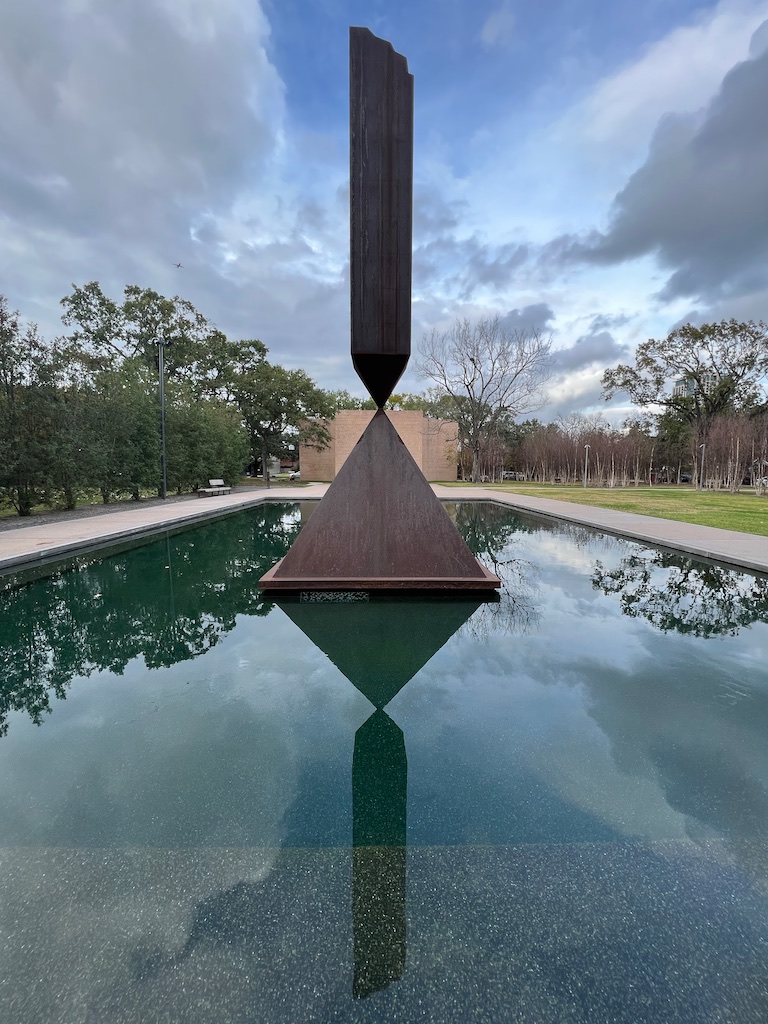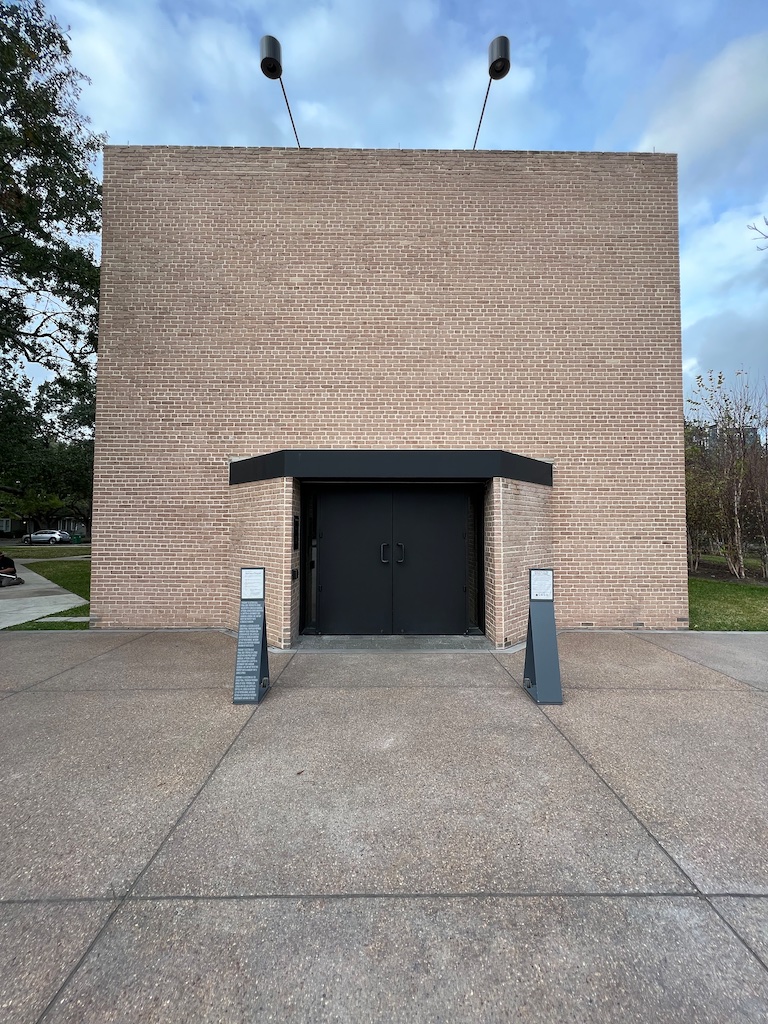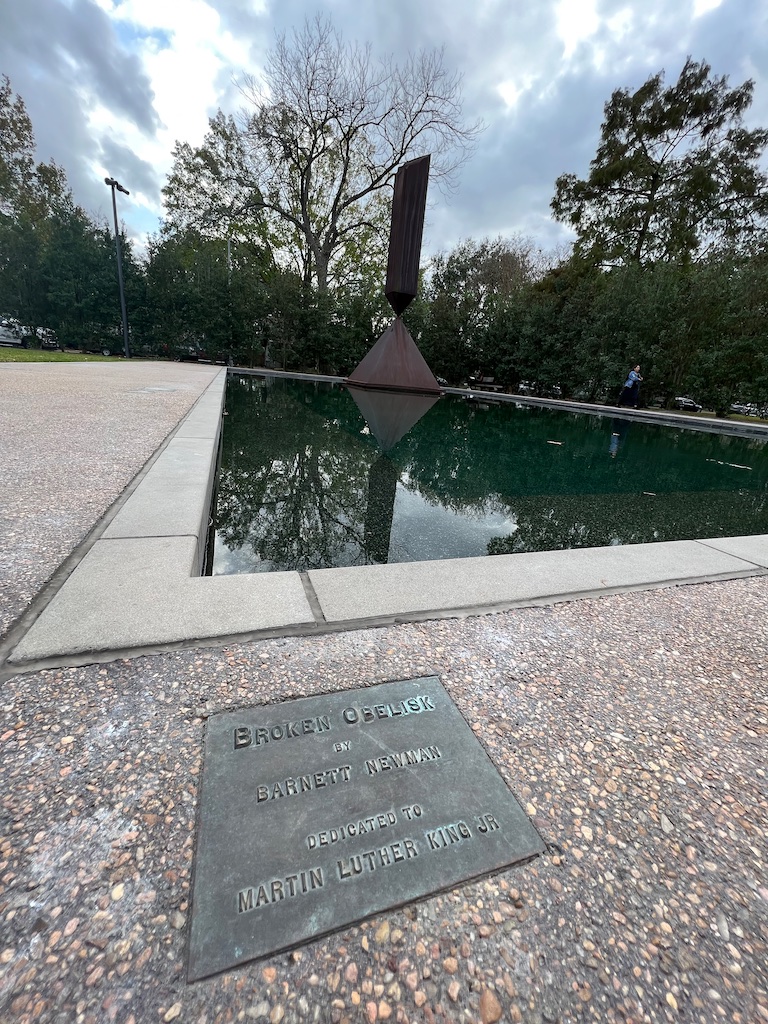Unbeknownst to many, Houston has a great museum and art scene.
You could easily spend a couple of days checking out marquee museums like the Houston Museum of Natural Science, Museum of Fine Arts, and the Space Center to only name a few options.
One museum-like attraction is the recently restored Rothko Chapel.
Part chapel, part museum, visiting this place is not like anything you’ve probably experienced.
Everyone seems to take something different with them after experiencing the chapel — spiritual awakenings, mindfulness, renewal, boredom, confusion….
There truly is no “wrong” way to experience the Rothko Chapel.
But what exactly can you expect when you give this place a visit?
In this article, I’ll tell you everything you need to know about the Rothko Chapel.
Table of Contents
What is the Rothko Chapel?
The Rothko Chapel is a small, octagonal chapel located in Houston, Texas, where a permanent collection of 14 works of art by Mark Rothko hang on the walls.
Opened in 1971, it is designed to be a place where art lovers and people of all faiths and religions can come to experience a sanctuary for contemplation. Rothko intended for the chapel to be his single most important artistic statement.
The Rothko Chapel recently finished a $30 million restoration project just before its 50th anniversary in 2021 and now also has a visitor center and other new facilities in the works.
Tip: Use the free app WalletFlo to help you travel the world for free by finding the best travel credit cards and promotions!
Where is the Rothko Chapel?
The Rothko Chapel is located at 3900 Yupon St, Houston, TX 77006.
It’s adjacent to the Menil Collection and The University of St. Thomas and found along a beautiful tree covered street.
There is also a visitor center located directly across the street and new facilities planned in the surrounding area as well. Adjacent to the chapel is a reflection pool with a memorial sculpture known as the Broken Obelisk, which is a tribute to Martin Luther King.
How do you access the Rothko Chapel?
The Rothko Chapel is free to visit and is open from 10am to 6pm (although signs now say from dusk to dawn).
The venue may be closed on Mondays.
No photography is allowed inside and you will be asked to turn off your cell phones as well.
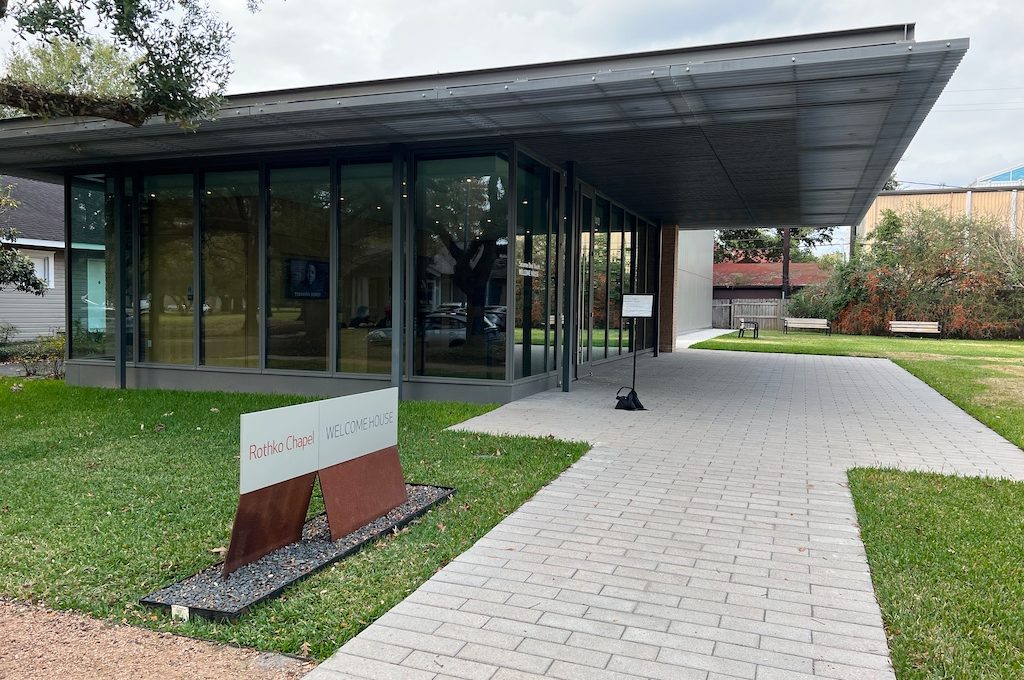
Rothko Chapel history and background
In the 1960s, Houstonians John and Dominique de Menil presented Mark Rothko with the opportunity to design a Catholic chapel for the University of St. Thomas.
Rothko’s take on the chapel would be to design something that would “speak to a contemporary mind and a contemporary spirit.”
Rothko started to work on the concept in 1964.
Difficulties emerged during the construction of the project as the initial architect Philip Johnson was not able to align his grander vision of the chapel with Rothko’s.
Johnson dropped from project which allowed Rothko to take the reins as he partnered with new architects.
While conceptualizing the project, Rothko utilized a large carriage house in New York City so that he could experiment with the scale of the room in the chapel.
One major feature of the room was a big skylight, something that Rothko wanted to be a defining feature in the chapel.
The idea was that this would emit a soft ambient light that would cast light on the paintings in a perfect way.
Rothko finished the 14 paintings (and four alternates) in 1967 but before the construction of the chapel began (and before ever visiting Houston), he sadly committed suicide in 1970.
Around that time, John and Dominique de Menil had parted ways with the University of St. Thomas and decided to move the chapel off campus.
This altered the nature of the chapel and is why it is now a non-denominational, interfaith destination.
Unfortunately, the whole lighting concept never really worked out as planned, either.
Many attempts were made over the years to try out different lighting solutions but none of them were sufficient to deal with the “gloominess problem” of the chapel.
They also caused problems with deterioration of the paintings.
Finally, with the most recent renovations a new skylight was installed consisting of multiple layers of UV-resistant glass screened by louvers.
In total, there are 280 reflective aluminum blades individually angled and spaced to evenly distribute light onto the paintings.
In addition to that, new landscape features were added like rows of birch trees and tall Savannah holly. And there are even more plans to add additional buildings and features in the area as more phases of the project take place.
You can learn about all the different phases of development by stopping by the visitor center.
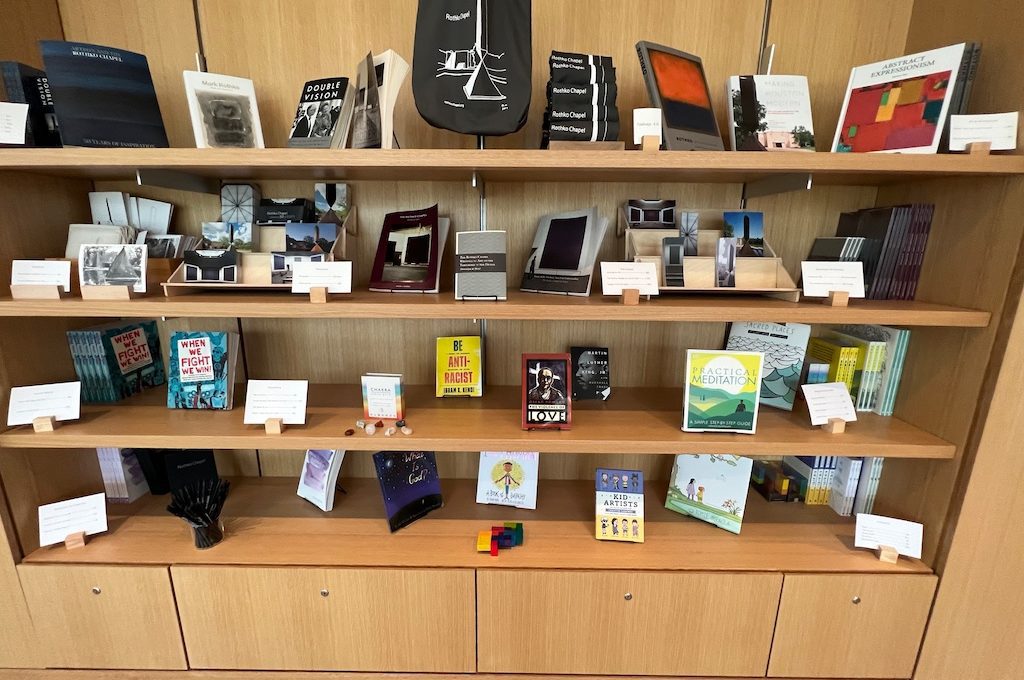
The Rothko Chapel experience
It’s a unique space worth visiting
Regardless of how you feel about the Rothko Chapel, one thing that you can’t deny is that it’s a unique attraction.
For that reason alone, I think it’s worth visiting at least once.
Simply put, there’s a reason why the chapel has been visited by some of the most notable world leaders including arcbishop Desmond Tutu, Nelson Mandela, the Dalai Lama, and even President Jimmy Carter.
There’s just something different about this place and what it stands for.
Rothko, a main attraction
For me personally, I was firstly just excited to see Rothko paintings.
I’m definitely not a real art aficionado.
And while I do love (or at least appreciate) a lot of modern abstract art, I still feel like I don’t “get” the vast majority of it.
Nevertheless, I constantly find myself in art museums trying to decipher and absorb whatever I can from modern art.
It’s interesting to find pieces that resonate with me and to ponder works that evoke different feelings and emotions that are often indecipherable.
But in a lot of ways, if I’m being completely honest, I’m also just there to witness the so-called greatness of artists who achieved remarkable levels of notoriety.
Over the years I had done a fair amount of research on Mark Rothko and considered him to be one of the most well-known modern abstract artists.
I’ve seen some of his work in museums before but not much so I was really excited to see what he had created for this space.
Unfortunately, his works in the chapel don’t really resemble the work he is most known for which are contrasting blocks of color.
What you’ll find inside are a total of 14 paintings, likely inspired by the number of the Stations of the Cross.
The paintings are mostly black but incorporate other dark hues and texture effects, which is just enough to make you ponder what is going on in the painting.
Three of the walls display triptychs, and the other five walls display only single paintings.
To me, the achievement of his work in the chapel is found in the overall assembly of all of the pieces rather than the individual paintings themselves.
In fact, I think the consensus is that the individual paintings are pretty underwhelming. I believe Rothko himself even went for something “you don’t want to look at.”

Our experience in the chapel
We had the privilege to visit the Rothko Chapel with no other visitors in the building.
While I initially was excited about the privacy we’d have for such an intimate and possibly almost spiritual-like experience, I quickly realized that there is no privacy in the Rothko Chapel.
As we entered the chapel, two staff members stood in shadowy doorways, faces partially covered with masks, watching our every movement.
There was a faint trace of an acknowledgment — bust mostly just silence and stillness in a very dimly lit octagon.
To be honest, it initially was an almost disturbing scene that made me feel like we had stepped in to some sort of cult-like séance.
But I told myself to just get over it and focus on trying to make the most of the experience.
So I methodically inspected the large artworks similar to how I would on a typical museum visit.
After taking some time to appreciate four or five of these massive paintings, I could feel myself getting drawn into the space.
It was an odd sensation and difficult to describe but the best way to put it is that it felt like something was stirring from within.
Unfortunately, the feeling just never quite fully developed, though.
There was just something about the quietness and stillness of the room and knowing that I was being watched that I couldn’t quite get over.
If this experience could somehow be a truly private one, I could see how it could help me tap in to something truly subliminal.
Indeed, I think I did get a small taste of that.
I realize there are security concerns with an exhibit-like feature such as this that probably require staff to be observing visitors at all times.
But that is just unfortunate given the nature of this attraction.
It’s not like a normal museum where the docents almost blend in with the surroundings.
This feels more like stepping into a deprivation chamber of sorts but having a couple of strangers there along with you for the ride (and to monitor your experience).
It just doesn’t quite jibe well for me.
After exploring the interior, we checked out the Broken Obelisk, which is a tribute to Martin Luther King.
Initially, it was supposed to be placed in front of City Hall in Houston but after a little bit of disagreements, it was placed by the Rothko Chapel.
In addition to paying tribute to Martin Luther King, it also represents the struggle for human rights, which ties into a broader mission of the chapel.
Every two years the chapel recognizes remarkable people who have denounced violations of human rights while facing enormous economic and political pressures and often personal peril.
The award is named after Óscar Romero, Archbishop of San Salvador, who was murdered on March 24, 1980.
Final word
For anybody remotely interested in art or unique experiences, I would consider the Rothko Chapel a must visit in Houston.
The reason is that it’s a unique attraction that could offer you a memorable experience while conjuring up feelings that you may not even be able to process.
It could also just feel like a weird way to spend a few minutes of your day.
But that is kind of the beauty of it to me — you really don’t know how the chapel is going to hit you until you give it a shot.
Daniel Gillaspia is the Founder of UponArriving.com and the credit card app, WalletFlo. He is a former attorney turned travel expert covering destinations along with TSA, airline, and hotel policies. Since 2014, his content has been featured in publications such as National Geographic, Smithsonian Magazine, and CNBC. Read my bio.

